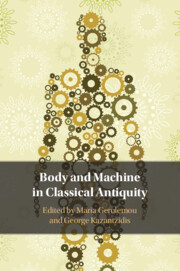Book contents
- Body and Machine in Classical Antiquity
- Body and Machine in Classical Antiquity
- Copyright page
- Contents
- Figures
- Contributors
- An Introduction to Body–Machine Intersections
- Part I Blended Bodies
- Part II The Technological Body
- Part III Towards the Mechanization of the Human Body
- Chapter 7 Aristotle on the Lung and the Bellows–Lungs Analogy
- Chapter 8 The Ill Effect of South Winds on the Joints in the Human Body
- Chapter 9 The Beauty That Lies Within
- Chapter 10 The Mechanics of the Heart in Antiquity
- Chapter 11 The Mechanics of Galen’s Theory of Nutrition
- Chapter 12 Iatromechanism and Antiquarianism in Morgagni’s Studies on Celsus, 1720–1761
- Conclusions or From Antiquity to the Early Modern
- Index of Passages
- General Index
- References
Chapter 7 - Aristotle on the Lung and the Bellows–Lungs Analogy
from Part III - Towards the Mechanization of the Human Body
Published online by Cambridge University Press: 13 July 2023
- Body and Machine in Classical Antiquity
- Body and Machine in Classical Antiquity
- Copyright page
- Contents
- Figures
- Contributors
- An Introduction to Body–Machine Intersections
- Part I Blended Bodies
- Part II The Technological Body
- Part III Towards the Mechanization of the Human Body
- Chapter 7 Aristotle on the Lung and the Bellows–Lungs Analogy
- Chapter 8 The Ill Effect of South Winds on the Joints in the Human Body
- Chapter 9 The Beauty That Lies Within
- Chapter 10 The Mechanics of the Heart in Antiquity
- Chapter 11 The Mechanics of Galen’s Theory of Nutrition
- Chapter 12 Iatromechanism and Antiquarianism in Morgagni’s Studies on Celsus, 1720–1761
- Conclusions or From Antiquity to the Early Modern
- Index of Passages
- General Index
- References
Summary
In a well-known passage (Juv. 13 (7).473a15–474a24), Aristotle preserves a fragment of Empedocles’ poem dealing with respiration, in which the clepsydra is used as a model for breathing. Although there is a substantial literature on this subject, most scholars have focused on explaining Empedocles’ account of the mode of operation of the clepsydra as well as on assessing the extent to which Aristotle’s interpretation does justice to Empedocles’ fragment. What has received little attention is the fact that Aristotle begins his criticism of Empedocles by offering a specific counterproposal of his own, one that rests on the idea that the mechanism of respiration can be explained in a much clearer fashion through the analogy of a forge bellows. References to bellows are actually already traceable to Homer. At the same time, the bellows–lungs analogy continued to be used for centuries after Aristotle. The aim of this chapter is to provide an overview of the existing literary and archaeological evidence about bellows in Greek antiquity in order to build a complete picture of its function and hence clarify Aristotle’s theory of respiration.
- Type
- Chapter
- Information
- Body and Machine in Classical Antiquity , pp. 181 - 202Publisher: Cambridge University PressPrint publication year: 2023
References
- 1
- Cited by

